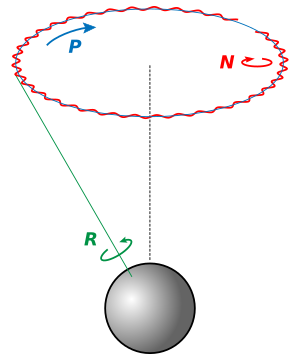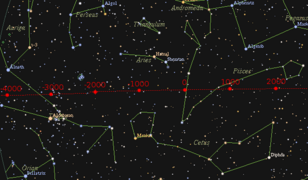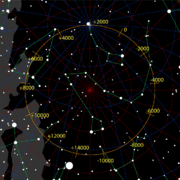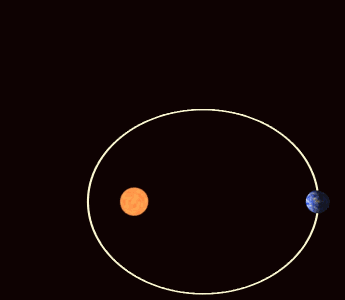Precession facts for kids
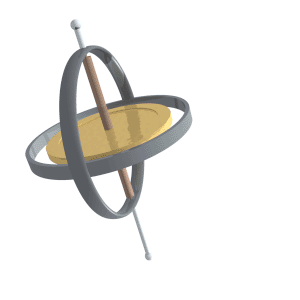
Precession is when the spinning axis of an object slowly changes its direction. Imagine a toy top that's spinning really fast. Instead of just staying perfectly upright, its top part might slowly circle around, even while it's still spinning. That slow circling motion of its axis is precession.
In physics, there are two main types of precession:
- Torque-free precession: This happens when no outside force (called a torque) is pushing on the object.
- Torque-induced precession: This happens when an outside force is pushing on the object.
In astronomy, precession describes the slow changes in how planets spin or move in their orbits. A very important example is the slow change in the direction of Earth's axis, which is called the precession of the equinoxes.
Contents
What is Torque-Free Precession?
Torque-free precession means there's no outside push or twist (torque) on a spinning object. Even without an outside force, the object's spin axis can still change direction. This happens if the object isn't perfectly balanced or symmetrical.
Think of a football thrown with a spiral. If it's thrown perfectly, it spins smoothly. But if it wobbles a bit as it flies, that wobble is a form of torque-free precession. The football's spin axis is changing direction even though no one is touching it in the air. Over time, this kind of precession tends to settle down, and the object will spin more smoothly.
What is Torque-Induced Precession?
Torque-induced precession, also known as gyroscopic precession, happens when an outside force (a torque) pushes on a spinning object. This push makes the object's spin axis move in a surprising way. Instead of falling over or moving in the direction of the push, the axis moves at a right angle to it!
A great example is a toy top. As it spins, its weight pulls it downwards. The ground pushes up on it. These two forces create a torque. But instead of the top just falling over, its axis slowly circles around. This is why a spinning top stays upright for a while, even when it's tilted.
This effect is used in many things:
- It helps explain how bicycles stay upright when moving fast.
- It's the main idea behind gyrocompasses, which are used to find direction without needing magnetism.
How Forces Cause Precession
The general rule for how a torque changes a spinning object's motion is:  This means the torque (
This means the torque ( ) causes a change in the object's angular momentum (
) causes a change in the object's angular momentum ( ) over time. Angular momentum is a measure of how much an object is spinning and in what direction.
) over time. Angular momentum is a measure of how much an object is spinning and in what direction.
Because of how torque works, it always acts at a right angle to the force that creates it. So, the spinning object's axis will change direction perpendicular to the applied force. This is what creates the circular motion of the precession.
For a simple spinning top, the speed of its precession (how fast its axis circles) depends on:
- How heavy it is.
- How fast it's spinning.
- How far its center of mass is from its tip.
- The angle it's tilted at.
Precession and Einstein's Theories
When we talk about precession, especially for objects near very large masses like Earth, Einstein's theories of relativity add tiny corrections to the classical (Newtonian) understanding. These corrections are usually very small, but they become important for very precise measurements or for understanding things like the orbit of Mercury.
One famous example is the orbit of Mercury. Its orbit around the Sun slowly shifts over time. While most of this shift can be explained by Newton's laws, there was a tiny extra shift that Newton's laws couldn't explain. Einstein's General Theory of Relativity perfectly predicted this extra shift, which was a big success for his theory!
Precession in Space
In astronomy, precession refers to the slow, continuous changes in how planets and other space objects spin or move in their orbits, all caused by gravity. These changes are very important for understanding long-term climate changes on Earth, like ice ages. This is part of what scientists call Milankovitch cycles.
Earth's Axial Precession
Axial precession is when the spin axis of a planet or other space object slowly traces out a cone shape in space. For Earth, this is also known as the precession of the equinoxes.
Earth's axis completes one full wobble cycle in about 26,000 years. This means that the North Star slowly changes over thousands of years. Right now, our North Star is Polaris, but in about 13,000 years, the star Vega will be the North Star! This slow change also affects where the Sun appears in the sky during different seasons.
The ancient Greek astronomer Hipparchus was one of the first to notice this precession around 2,000 years ago. Later, Newtonian physics explained why it happens. Earth is not a perfect sphere; it bulges out at the equator. The gravity of the Moon and Sun pull on this bulge, trying to straighten Earth's tilt. But because Earth is spinning, this pull causes the axis to precess instead of just straightening up.
Apsidal Precession
Planets don't orbit the Sun in a perfectly fixed ellipse every time. Instead, their elliptical orbits slowly rotate over time. This makes their path look a bit like a flower petal. This is called perihelion precession or apsidal precession.
This happens because the gravitational forces from other planets slightly pull on each other, causing their orbits to shift. As mentioned before, the tiny extra shift in Mercury's orbit was a key piece of evidence that supported Einstein's theory of relativity.
Nodal Precession
The points where a planet's orbit crosses a reference plane (like Earth's orbit around the Sun) are called Orbital nodes. These points also slowly shift over time, which is known as nodal precession. This is important for understanding the orbits of satellites and the Moon.
See also
 In Spanish: Precesión para niños
In Spanish: Precesión para niños
- Larmor precession
- Nutation
- Polar motion
- Precession (mechanical)
- Precession as a form of parallel transport


